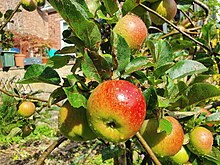
'Golden Delicious' is a cultivar of apple. It is one of the 15 most popular apple cultivars in the United States. It is not closely related to 'Red Delicious'.

Cox's Orange Pippin, in Britain often referred to simply as Cox, is an apple cultivar first grown in 1825, at Colnbrook in Buckinghamshire, England, by the retired brewer and horticulturist Richard Cox. Though the parentage of the cultivar is unknown, Ribston Pippin seems a likely candidate. DNA analysis of major apple pedigrees has suggested Margil as the parent of Cox, with Ribston Pippin being another Margil seedling. The variety was introduced for sale by the 1850s by Charles Turner, and grown commercially from the 1860s, particularly in the Vale of Evesham in Worcestershire, and later in Kent.

The Egremont Russet is a cultivar of dessert apple, of the russet type. It has a rich, nutty flavour and crisp, firm and fairly juicy flesh.

A cooking apple or culinary apple is an apple that is used primarily for cooking, as opposed to a dessert apple, which is eaten raw. Cooking apples are generally larger, and can be tarter than dessert varieties. Some varieties have a firm flesh that does not break down much when cooked. Culinary varieties with a high acid content produce froth when cooked, which is desirable for some recipes. Britain grows a large range of apples specifically for cooking. Worldwide, dual-purpose varieties are more widely grown.

Cortland is a cultivar of apple developed at the New York State Agricultural Experiment Station in Geneva, New York, United States in 1898. The apple was named after nearby Cortland County, New York. It is among the fifteen most popular in the United States and Canada. Sugar 12.5%, acid 8 g/litre, vitamin C 6 mg/100g.

'Ribston Pippin' is a triploid cultivar of apples, also known by other names including 'Essex Pippin', 'Beautiful Pippin', 'Formosa', 'Glory of York', 'Ribstone', 'Rockhill's Russet', 'Travers', and 'Travers's Reinette'.

Claygate Pearmain is an apple cultivar. It was found at Claygate, Surrey in England and brought to the attention of the Royal Horticultural Society by John Braddick in 1821. The apple was a popular eating apple in Victorian times and spread through England and to America.
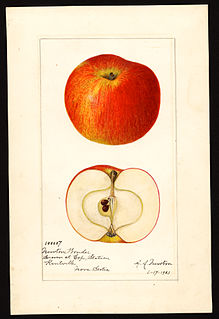
Malus domestica Newton Wonder is a cultivar of apple which is usually eaten cooked due to its sourness. The variety has a similar but slightly sweeter taste than the Bramley apple and is usually used in pies or as a preserve.

The 'Sunset' is an apple cultivar derived from the Cox's Orange Pippin cultivar. Both are found in Great Britain. The fruit has red stripes and an orange flush over a gold background. Usually, part of the apple is red while part of it is yellow. It is similar to 'Cox's Orange Pippin' in that it displays some russetting. The 'Pixie' apple is a distant descendant.

'Akane', also known as 'Tokyo Rose', 'Tohoku No.3' and 'Prime Red', is a Japanese cultivar of domesticated apple, that according to Orange Pippin is one of the best early season apples.

'Worcester Pearmain' is an early season English cultivar of domesticated apple, that was developed in Worcester, England, by a Mr. Hale of Swanpool in 1874. It was once the most popular cultivar in England for early autumn harvest and is still popular to keep in the garden. It has been extensively used in apple breeding.

'Allington Pippin' is an English cultivar of domesticated apple, with a strong flavour that includes hints of pineapple.
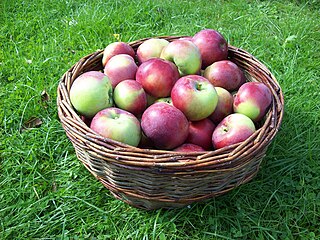
'Birgit Bonnier' is a modern cultivar of domesticated apple which have some resistance to apple scab and mildew.
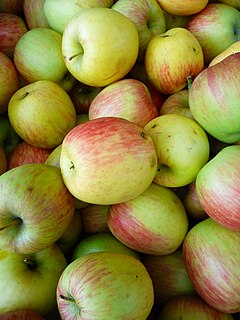
'Delbarestivale', also called 'Delcorf', is a cultivar of domesticated apple, which was developed by the Delbard nursery in France. It is a very sweet apple. 'Delcorf'f' is a parent of the 'Zari' apple and the 'Nicogreen' apple.

Winston is an English cultivar of domesticated apple which was first named Winter King because of its availability in the winter, but was renamed as Winston in 1944 or in 1945, after Winston Churchill.

Reinette du Canada or Canadian Reinette is, despite its name, an old French cultivar of domesticated apple. It is a reinette type of golden apple, with much russeting, which keeps shape in cooking and is mainly used for that purpose especially in apple strudel.

Suntan is an English cultivar of domesticated apple that have earned the Award of Garden Merit by the Royal Horticultural Society in 1999.
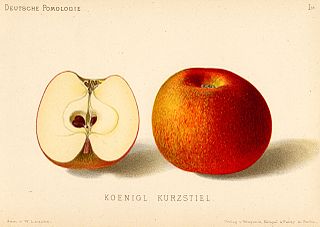
Court Pendu Plat is an extremely old French cultivar of domesticated apple that was first recorded in 1613. The cultivar definitely dates back to earlier than the 17th century, and was probably cultivated by the Romans. It is known for its intense flavor which mellows with storage.

Grenadier is an English cultivar of domesticated apple mainly used for cooking. It originated in the mid-19th century in Buckinghamshire. It was first recorded in 1862 in Maidstone, Kent, exhibited by Charles Turner of Slough, Berkshire, and then commercially introduced by Bunyard Nursery.
